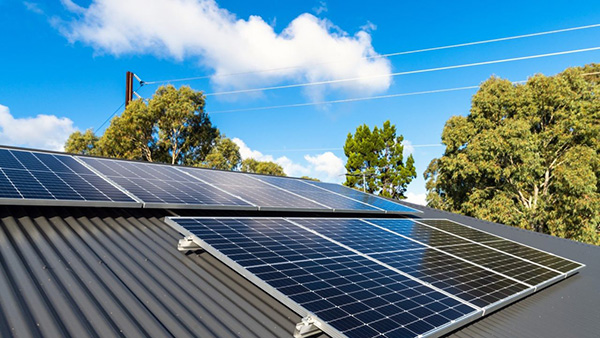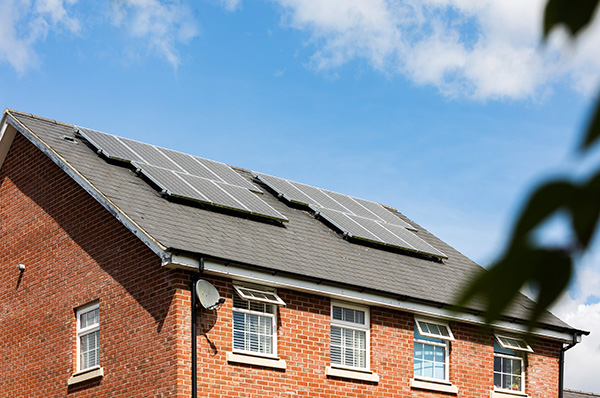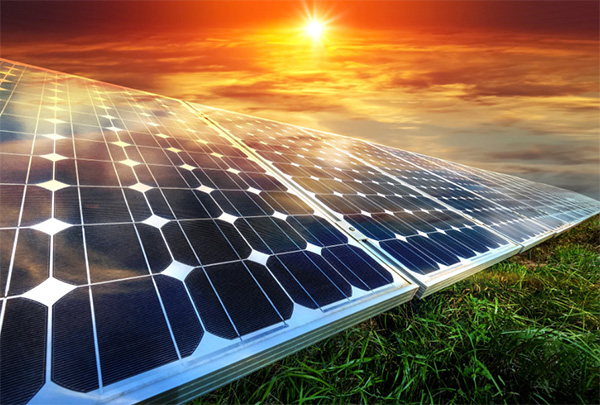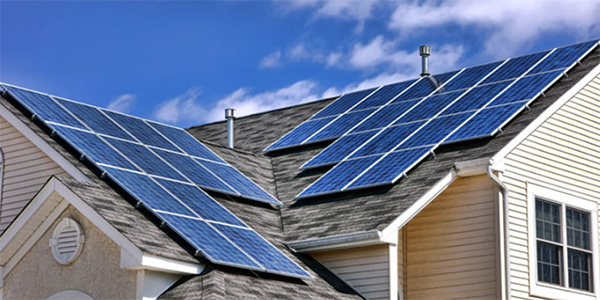Description
The best type of solar panel for a home often hinges on individual needs and circumstances. Monocrystalline panels are favored for their high efficiency and sleek design, while polycrystalline panels are more budget-friendly but slightly less efficient. Thin-film panels, suitable for larger areas, have lower efficiency. It's crucial to consider factors like budget, roof space, and regional sunlight when choosing, and consultation with a solar installer is recommended.

Solar Panels for Home Use
In an era defined by the quest for sustainable energy solutions, solar panels have cemented their position as a groundbreaking technology, fundamentally transforming our approach to home energy. A notable decline in costs by over
70% within the past decade has led to a surge in solar panel installations in residential settings. This shift not only offers homeowners the opportunity to diminish their carbon footprint but also paves the way for significant savings on electricity expenses.
Benefits of Installing Solar Panels at Home
The allure of solar panels for homeowners is backed by a multitude of advantages:
- Financial Savings: Beyond the initial outlay, the potential for homeowners to substantially curtail their monthly electricity expenses becomes palpable. Certain homeowners even achieve the commendable milestone of zero electricity bills, contingent on their synergy of energy consumption and solar energy output.
- Increase in Property Value: Residences fortified with solar panel systems witness an elevation in property worth and often experience expedited sales compared to counterparts without solar provisions. Research indicates that potential homebuyers demonstrate a propensity to offer an average of 4% more for homes fortified with solar mechanisms.
- Reduced Carbon Footprint: The innate ability of solar panels to produce pristine, green energy signifies a monumental step towards environmental preservation. Transitioning away from a heavy reliance on fossil fuels, homeowners can enact a profound reduction in their carbon emissions. To put it in perspective, a quintessential residential solar panel system curtails carbon emissions by an astonishing 3 to 4 tons annually, an environmental contribution analogous to the nurturing of over 100 trees each year.
How Solar Panels Work
Often referred to as photovoltaic (PV) panels, these solar devices possess the capability to transmute sunlight into electricity. Delving into the mechanics of this transformation:
- Absorption of Light: The journey commences when the solar panel becomes a beacon, absorbing the sun's rays within its cells.
- Creation of Electron-Hole Pairs: The assimilated energy from the sunlight instigates a state of excitement within the electrons present in the cells. This heightened state precipitates the genesis of electron-hole pairs.
- Flow of Electric Current: Propelled by their newfound energy, these electrons navigate towards the conductive metal plates positioned adjacent to the cell, engendering an electric current. Once harnessed, this current serves as a powerhouse, energizing homes.
Empowered with foundational knowledge regarding solar panels, homeowners are better equipped to make astute decisions about incorporating solar installations. As we continue to witness technological evolution, solar energy is poised to further its dominance in the realm of sustainable energy solutions.

Different Types of Solar Panels Explained
Solar panels, a cornerstone of renewable energy, have rapidly evolved in terms of efficiency, design, and affordability. As the market has expanded, a variety of solar panels have been developed, each with its own unique characteristics and advantages. While all solar panels serve the fundamental purpose of converting sunlight into electricity, understanding their differences is essential for homeowners and businesses aiming to make the most informed decision for their specific needs.
Monocrystalline Solar Panels (Mono-Si)
Monocrystalline panels are recognized by their uniform dark black color and rounded edges. Made from a single pure silicon crystal, these panels are known for their high efficiency and performance. Owing to their high purity silicon, they tend to have a higher power output and can achieve efficiencies of around 20%. Their durability is also commendable, with many lasting beyond 25 years. However, they usually come at a higher cost compared to other types due to the intricate manufacturing process.
Polycrystalline Solar Panels (Poly-Si)
Characterized by their blue hue and a somewhat speckled appearance, polycrystalline panels are manufactured using multiple silicon fragments melted together. These panels, while generally less efficient than monocrystalline (typically around 15-17%), are more cost-effective due to a simpler manufacturing process. A trade-off to consider with polycrystalline panels is their slightly larger footprint for the same power output compared to Mono-Si panels.
Thin-Film Solar Panels (TFSP)
A stark contrast to traditional silicon panels, thin-film panels are sleek and flexible. Composed of layers of photovoltaic material deposited on metal or glass, their efficiency generally hovers around 10-12%. Their primary advantage lies in their flexibility, making them suitable for curved surfaces or locations where weight is a consideration. However, they require a larger area to generate the same amount of power as their crystalline counterparts.
Concentrated PV Cell (CVP) and Concentrated Solar Power (CSP)
Concentrated PV cells are highly efficient solar panels that use lenses or mirrors to focus sunlight onto a small area of high-efficiency PV cells. They can achieve an impressive efficiency of over 40%, especially when paired with solar tracking systems. On the other hand, Concentrated Solar Power systems use mirrors or lenses to focus a large area of sunlight onto a small target, usually a thermal receiver, converting sunlight into heat rather than electricity. This heat can be stored and converted into electricity using turbines.
Biohybrid Solar Panels
An exciting innovation in the world of solar energy, biohybrid solar panels incorporate organic material (typically photosynthetic proteins) into the solar cells. These panels aim to mimic the natural process of photosynthesis, offering a potentially more sustainable and environmentally-friendly option. While still in the early stages of commercial development, they showcase a promising future in harnessing sunlight in novel ways.
Selecting the right type of solar panel hinges on various factors, including budget, space, and desired efficiency. As research and technology progress, we anticipate even more advancements and choices in the realm of solar energy.

Comparing the Efficiency and Cost
The decision to invest in solar panels is often influenced by two primary factors: efficiency and cost. These elements play a pivotal role in determining the value of the investment over time. Here, we will delve into a comparative analysis of various solar panels concerning their efficiency rates and cost implications.
Efficiency Rates Across Different Panel Types
Efficiency plays a significant role in determining how much electricity a solar panel can produce. Higher efficiency means that the panel can convert more sunlight into electricity, often requiring less space to meet a particular energy need. Here's a table comparing the efficiency rates of different solar panel types:
| Solar Panel Type |
Average Efficiency Rate |
| Monocrystalline (Mono-Si) |
20% |
| Polycrystalline (Poly-Si) |
16% |
| Thin-Film (TFSP) |
11% |
| Concentrated PV Cell (CVP) |
42% |
| Biohybrid |
Currently under research, but estimated around 8-10% |
Cost Analysis: Initial Investment vs. Long-Term Savings
While initial costs can be a significant deciding factor, it's essential to consider long-term savings and the lifespan of the panels. Here's a comparative cost analysis:
| Solar Panel Type |
Average Cost per Watt (USD) |
Expected Lifespan (Years) |
Long-Term Savings (over 20 years, USD) |
| Monocrystalline (Mono-Si) |
$1.00 - $1.50 |
25-30 |
$20,000 - $25,000 |
| Polycrystalline (Poly-Si) |
$0.90 - $1.20 |
23-27 |
$18,000 - $22,000 |
| Thin-Film (TFSP) |
$0.70 - $1.00 |
10-15 |
$10,000 - $15,000 |
| Concentrated PV Cell (CVP) |
$3.00 - $3.50 |
20-25 |
$30,000 - $35,000 |
| Biohybrid |
Data not yet available due to early research stages |
TBD |
TBD |
Note: Long-term savings are estimations and can vary based on various factors, including local energy prices, solar incentives, and individual energy consumption.
This data-driven comparison aids in discerning the most suitable solar panel type based on efficiency, cost, and long-term value. As solar technology continues to evolve, it's imperative to stay updated with the latest advancements and market trends.

Factors to Consider When Choosing Solar Panels for Home
Solar energy has risen in popularity as a reliable, green, and cost-effective source of power. While the overarching decision to switch to solar might seem straightforward, the underlying process demands careful deliberation over a multitude of factors. These elements will not only affect the immediate installation process but also the long-term benefits that one hopes to derive. Here, we dive deep into the essential criteria homeowners should evaluate when considering a solar installation.
Climate and Sunlight Availability
Your geographical location plays a pivotal role in determining the viability of solar panels. Homes situated in regions with abundant sunshine throughout the year stand to benefit the most.
- Peak Sun Hours: The number of hours the sun produces enough light to generate electricity is crucial. For instance, southwestern US states like Arizona or New Mexico average 6-7 peak sun hours daily, making them optimal for solar installations.
- Seasonal Variations: While places like Seattle might receive less sunlight in winters, they can still benefit from solar panels during sunny summer months. It's all about balancing annual energy production with consumption.
Roof Size and Orientation
The structure and direction of your roof influence the amount of sunlight your panels receive and, consequently, their efficiency.
- Size: A larger roof can accommodate more panels, allowing for higher energy production. Typically, a standard solar panel requires around 15-20 square feet of roof space.
- Orientation: In the northern hemisphere, roofs facing south capture the most sunlight. However, east and west-facing roofs can also be suitable, albeit with slightly reduced efficiency.
Energy Needs and Consumption
Tailoring your solar system to your home's energy needs is crucial to maximize cost savings.
- Monthly Energy Bills: Analyzing your electricity bills from the past year can provide insights into your monthly energy consumption, helping you determine the size of the solar system you need.
- Future Changes: Consider any potential changes in your energy consumption patterns. Planning on buying an electric vehicle or adding a home addition? Factor these in.
Maintenance and Durability
Solar panels are a significant investment, and their longevity and maintenance requirements are crucial considerations.
- Lifespan: Most solar panels come with a warranty of 25 years, suggesting that they can efficiently function for at least that long if not longer.
- Maintenance: Generally, solar panels require minimal upkeep. Occasional cleaning and periodic checks ensure they operate optimally. Some brands might also offer maintenance packages at an additional cost.
Local Incentives and Tax Credits
Financial incentives can significantly reduce the cost of solar panel installations.
- Federal Solar Tax Credit: This initiative allows homeowners to deduct a percentage of the cost of installing a solar energy system from their federal taxes.
- State and Local Incentives: Many states and municipalities offer additional tax credits, rebates, and grants. It's advisable to research local incentives available in your area.
In conclusion, integrating solar panels into your home isn't merely about joining the green energy revolution. It requires a thoughtful approach, meticulous research, and an understanding of your unique circumstances. By considering the above factors, homeowners can make an informed and strategic choice, ensuring that their solar venture is both ecologically and economically rewarding.
Installation and Maintenance Tips
Solar panels are more than just an eco-friendly energy solution; they're a long-term investment in your home's infrastructure and future energy consumption. While the idea of harnessing solar energy is exciting, it's crucial to understand the installation and maintenance nuances to ensure the system's longevity and optimum performance. Let's explore some essential tips for installing and maintaining your solar panels.
Choosing the Right Installer
The process of selecting an installer for your solar panels is akin to hiring a contractor for home renovations. You want someone skilled, experienced, and with a reputation for quality work. Here's where brands like
Tongwei come into play. Known for their commitment to solar energy and top-tier products, selecting a certified Tongwei installer ensures that your system will be set up with precision and expertise.
Before finalizing any installer:
- Look into their credentials, certifications, and customer reviews.
- Ask about their experience, especially with residential installations.
- Ensure they offer post-installation support, a clear indication of their dedication to customer satisfaction.
Tips for Maintaining Your Solar Panels
While solar panels are designed for minimal maintenance, it's still important to keep an eye on them to ensure they operate at their best. A well-maintained solar panel system can remain effective for over 25 years.
- Regular Cleaning: Dust and debris can accumulate on the panels, reducing their efficiency. Gently cleaning the surface with water and a soft brush every few months can prevent this.
- Monitor Performance: Keep tabs on your system's energy output. A sudden drop in efficiency might indicate an issue that requires attention.
- Regular Inspections: Yearly inspections by professionals can spot potential issues before they escalate, ensuring the longevity of your system.
Safety Precautions and Considerations
Safety is paramount, both during the installation phase and throughout the lifespan of your solar panels.
- Electrical Safety: Always ensure that the electrical connections are secure and that there's no exposed wiring. It's advisable to periodically have these checked by a certified electrician.
- Roof Safety: If you're inspecting or cleaning the panels yourself, always ensure you have proper safety equipment, like harnesses, to prevent any accidents.
- Wildlife Interference: Birds or squirrels might nest under or around the panels. Consider installing critter guards to prevent wildlife interference, which can damage the panels or wiring.
In conclusion, while the idea of switching to solar energy is enticing, it comes with responsibilities. Proper installation, backed by consistent maintenance, is the key to harnessing the sun's power effectively. With brands like Tongwei offering top-notch products and services, homeowners are better poised to make the most of their solar journey.







